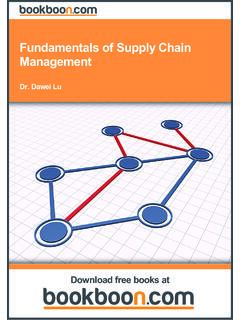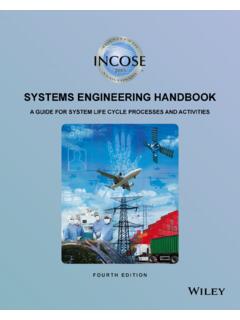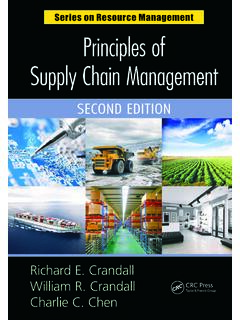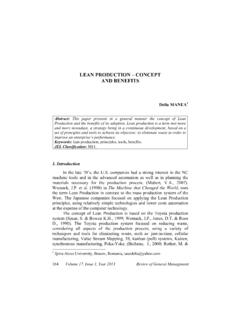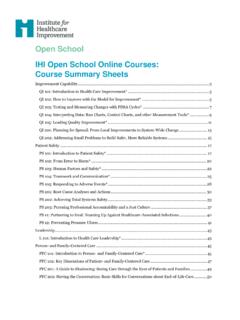Transcription of An Introduction to 6S
1 IntroductionEver take a good look around your office, especially after some hectic period of work? Ifit gets like mine, it can look like a cyclone hit it. Drafts of materials stacked on eachother. Edited copy on the floor around my desk. Project reference materials stacked upon my spare table, along with journal articles I put off reading because I didn't have timeto read them when they came in. The focus for most of us is on getting the work in-handdone and that can mean we let good organization go. Unfortunately, this can become ahabit and, when the work space is shared, it can become a significant hindrance toworking efficiently and, sometimes, safely. One contribution of the lean approach to business improvement has been a set of toolsthat anyone can leverage to improve workplaces and work processes. One of thesetools, 6S (originally labeled 5S; see Exhibit 1), addresses just the situation I people may think of it as relating to manufacturing workplaces, but it is just as ap-plicable to office settings.
2 As with all lean tools, 6S is about eliminating waste and maxi-mizing value-added work. To this end, 6S uses its process to create and maintain anorganized, clean, safe, and efficient setting that enables the highest level of value-added performance. This means eliminating search, travel, transporting materials, in-ventory, and hazards. It achieves its ends by introducing organization and orderliness,eliminating unneeded materials, and establishing self-discipline. In a sense, it transferssome principles of "time management " from the "virtual space of your work schedule" tothe physical space of your office or shop area. Here are our labels for the 6Ss and their meaning. Sort - Distinguish between what is needed and not needed and remove the - Enforce a place for everything and everything in its - Clean up the workplace and look for ways to keep it - Maintain and monitor adherence to the first three - Follow the rules to keep the workplace 6S-right "maintain the gain.
3 "Exhibit 1. The Origins of 6 SWhat we call "6S" derives from "5S" the method of workplace organization and visual controlsdeveloped by Hiroyuki Hirano (5 Pillars of the Visual Workplace, Portland, OR: Productivity Press,1990). The five "Ss" refer to five Japanese words seiri, seiton, seiso, seiketsu, and means to separate needed and unneeded materials and to remove the latter. Seiton meansto neatly arrange and identify needed materials for ease of use. Seiso means to conduct acleanup campaign. Seiketsu means to do seiri, seiton, and seiso at frequent intervals and tostandardize your 5S procedures. Shitsuke means to form the habit of always following the firstfour origin of 5S seems rooted in the works of two American pioneers who were scrupulouslystudied by Japanese managers. These were Frederick W. Taylor's Scientific management (1911)and Henry Ford (1922).
4 Indeed, Ford's CANDO program (Cleaning up, Arranging, Neatness,Discipline, Ongoing Improvement), which builds on Taylor's work, appears as the obvious originfor Introduction to 6S - Don RollPublished at: (First published February 13, 2005)1 2005-2011 Vital Enterprises - Hope, Maine 04847 Safety - Eliminate hazards. (We added this sixth "S" so we could maintain the fo-cus on Safety within our lean events and embed safe conditions into all ourimprovements.)There are a number of great reasons for using 6S. It is a natural for building teams whoshare a common work area. For one thing, every team member benefits from it and foranother, it fits common sense. Everyone has had the experience of losing work, mis-placing documents and spending frustrating and wasteful time looking for them, trippingon objects left in the working place, etc. As a consequence, 6S is a tool whose value isreadily grasped.
5 Everyone can get their arms around the concept of "a place for every-thing and everything is in it's place." Another great quality of 6S is that it is doubly ena-bling. It enables people to be free of aggravations that hinder their work and it is awonderful way to involve people in improving their own work settings. That enablesgreater employee empowerment. Finally, the visual impact of a 6S event makes the im-provement it produces impossible to miss and this creates a real sense of achievementand pride that can form the beginning of a more significant cultural transition (see Ex-hibit 2, next page).CautionDo not be mislead by the before and after photos that everyone doing 6S are valuable portrayals of measurable improvements, but they rivet attention to theworkplace and, in that sense, they can mislead. 6S may appear to focus on a work-place sorting, straightening, etc.
6 The area in which people work, but this is not root focus of 6S is the work process that is executed in the workplace. The reasonis this. All lean is about producing products that are fully value adding to a processes that are themselves absolutely value adding (meaning 100% devoid ofwaste) can produce such products. While detecting disorganization in a workplace maybe obvious, it is not obvious what, in a concrete sense, good organization is. Should toolX go by work station A or B? Where should we place the copier in this office to reducetravel and transport? In the center of the workplace? You can't answer these questionsin a way that eliminates waste unless you understand the work process that people im-plement in that space and the job each person does. Also, what information should beposted and where? Again, you can't answer either of these questions if you do not un-derstand the work process people are implementing.
7 So, the root focus for 6S is thework process, not the workplace. In office workplaces, where it is common for one areato service many work processes, this is especially critical. It is quite possible to optimizea workplace for one work process while making it even more problematic for others us-ing the same space. So an important initial step to applying 6S is to identify the workprocess you are to benefit and every other work process using the space you will solutions must serve them all. An Introduction to 6S - Don RollPublished at: (First published February 13, 2005)2 2005-2011 Vital Enterprises - Hope, Maine 04847 Exhibits 2. 6S's Impact Is Easy to Understand1 BeforeAfterOffice Example1 Thanks to Frank Butz and Tony Manorek for the use of these photos. Keep up the good work guys!An Introduction to 6S - Don RollPublished at: (First published February 13, 2005)3 2005-2011 Vital Enterprises - Hope, Maine 04847 You should also recognize a related point.
8 6S will need to be recycled, if your companyis truly committed to continuous improvement using, for example, Kaizen. That is be-cause you will modify the work process over time, meaning that your 6S solutions willalso require 6 SWe use a three phase approach to doing 6S. We get ready for the event, do it, and thenfollow-up to make sure our improvements sustain. We adopted steps and materials fromthe Kaizen method documented in the Kaizen Desk Reference Standard, with the writ-ten permission of the copyright owner (Vital Enterprises).Getting ReadyTo get ready for the event, we meet with the managerof the work area to identify what he or she wants theevent to achieve. You need to know the manager'sidea of how the work process in the target work areaneeds to improve and what business benefits that im-provement should produce. With this information, wedescribe a scope for the proposed event.
9 I do notdraft a formal strawperson mission and goals, but I doform an idea of what these should be. One change Iam considering is adopting the practice of document-ing the strawperson mission, goals, and "do's anddon'ts" as is recommended in the Kaizen Desk Refer-ence Standard. I can use the electronic form in theKaizen Tool Kit, and this should make confirming themanager's expectations for the event easier to do andprovide a surer result. Up until now, however, I havenot done I confirm the manager s expectations, we identify the people who will be on the 6 Steam and talk with them to assess what they understand about 6S, add to that under-standing, and get their judgments about how effectively the workplace currently sup-ports getting their jobs done. The team is made up of people working in the setting thatwe will 6S. Sometimes, that's everyone.
10 Other times, the setting is large or there may beshift workers. If I can get to visit the work site, I do. There is no substitute for direct ob-servation and meeting people face-to-face. If not, I use the information from the man-ager and from my conversations with workers to evaluate whether doing the eventmakes sense. I need to be sure I can use 6S to accomplish the purposes the managerhas expressed and provide the improvements that employees feel will be meaningful. Ialso need to make sure that there is a good business case for the event. Events taketime. Large events will take as much as five days. I need to see the possibility that 6 Swill take out enough waste (travel, transport, excess materials, etc.) to justify its I make the judgment, I share it with the manager and the workers and start thepreparation for the Introduction to 6S - Don RollPublished at: (First published February 13, 2005)4 2005-2011 Vital Enterprises - Hope, Maine 04847 Exhibit 3.

